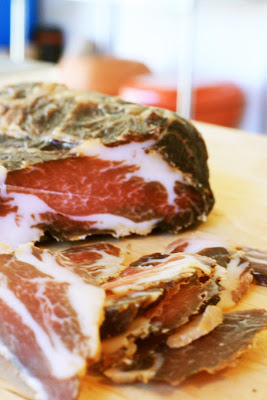Thank god it's that point in the summer where I can eat ripe tomatoes everyday of the week. Yesterday was tomatoes on white bread with mayo, the day before was marinated tomatoes, but today... well today I've got something special.
Today, it's grits with sautéed callaloo and cherry tomatoes.

Grits can be easy, or they can kick you in the ass. I've certainly learned this from experience. I like to use equal parts grits to water in a pot over low heat, but I'll add water as needed, but make sure that you do not look away from those little flecks of corn for more that two minutes or you will be scrubbing the hell out of that pot. I'm not kidding, just watch it like you would a two-year-old in a room full of cleaning products, but unlike the child, stir the grits every few minutes. Do this until you are happy with the consistency. Some like their grits a bit more toothsome, some like 'em real creamy (insert joke here). Just add the water as needed and let the grits simmer until you think they're ready.
Once they're done, or you've said "f it", add a nice size tab of butter, a pinch of salt, and a crack of black pepper. Well that takes care of the grits, now there's more to be done.
For that callaloo... get a pan on medium heat and toss in some diced bacon, or don't, instead you could use a bit of oil or butter, I really don't care, but where there's bacon, there's bacon grease, and when you have bacon grease, you have pan lubrication. That logic seems pretty sound to me.
Alright then.
Your bacon has rendered its fat an lubed the pan all while getting a crisp exterior. Toss in some chopped callalloo and maybe a bit of those wonderful scallions you have sitting in your fridge. Stir it all together and throw a lid on it. Once the leaves are nicely tenderized, kill the heat and lay them across you beautiful bowl of grits.
For the cherry tomatoes, simply quarter them and toss them atop your bowl of grits and greens. They add a wonderful coolness to the hot bowl dish.

So there you have it. Grits with Callaloo & Tomatoes.





















 I marinated it overnight in some rice vinegar, miso paste, ginger, soy sauce, Sriracha, brown sugar, and garlic. Remove the skin the next day, but whatever you do, do not, I repeat, DO NOT THROW IT AWAY! You could roast it at a super high temperature and make some crispy roasted pig skin, or braise it, or even dehydrate it and deep fry. Just don't toss it in the trash.
I marinated it overnight in some rice vinegar, miso paste, ginger, soy sauce, Sriracha, brown sugar, and garlic. Remove the skin the next day, but whatever you do, do not, I repeat, DO NOT THROW IT AWAY! You could roast it at a super high temperature and make some crispy roasted pig skin, or braise it, or even dehydrate it and deep fry. Just don't toss it in the trash. While you've got your belly in the oven, make some white bread dough. I chose to use pork and duck fat in mine. Let the dough rise and pound it down. I'm not a baker so you may want to get some advise or guidance elsewhere on the whole dough making thingy. I can tell you that once it would be ready for making a loaf of bread, you should tear off some little pieces, roughly the size of a ping pong ball or a silver dollar, and roll them into balls. Let those pieces of dough rise under a towel or plastic wrap for a bit.
While you've got your belly in the oven, make some white bread dough. I chose to use pork and duck fat in mine. Let the dough rise and pound it down. I'm not a baker so you may want to get some advise or guidance elsewhere on the whole dough making thingy. I can tell you that once it would be ready for making a loaf of bread, you should tear off some little pieces, roughly the size of a ping pong ball or a silver dollar, and roll them into balls. Let those pieces of dough rise under a towel or plastic wrap for a bit. 




 Spread some homemade mustard on some white bread and you've got yourself some pork lovin' lunch.
Spread some homemade mustard on some white bread and you've got yourself some pork lovin' lunch.









 Chop the tomatoes and layer them in the pan. All of their juices will heat up and coat the layers beneath. Ratatouille is like a savory, Italian, vegetable layer-cake and as for the final layers, add a couple handfuls of sliced Cremini mushrooms and a good dose of fresh herbs (rosemary, mint, basil, oregano, chives)
Chop the tomatoes and layer them in the pan. All of their juices will heat up and coat the layers beneath. Ratatouille is like a savory, Italian, vegetable layer-cake and as for the final layers, add a couple handfuls of sliced Cremini mushrooms and a good dose of fresh herbs (rosemary, mint, basil, oregano, chives)
 Once all of your layers are stacked up, simply place a cover over that beast and let it cook away. Once you think everything is cooked to your liking of tenderness, give it all a big stir and let it cook for just a few minutes more and....presto..... Ratatouille.
Once all of your layers are stacked up, simply place a cover over that beast and let it cook away. Once you think everything is cooked to your liking of tenderness, give it all a big stir and let it cook for just a few minutes more and....presto..... Ratatouille.
